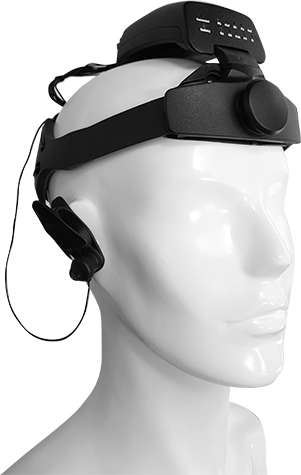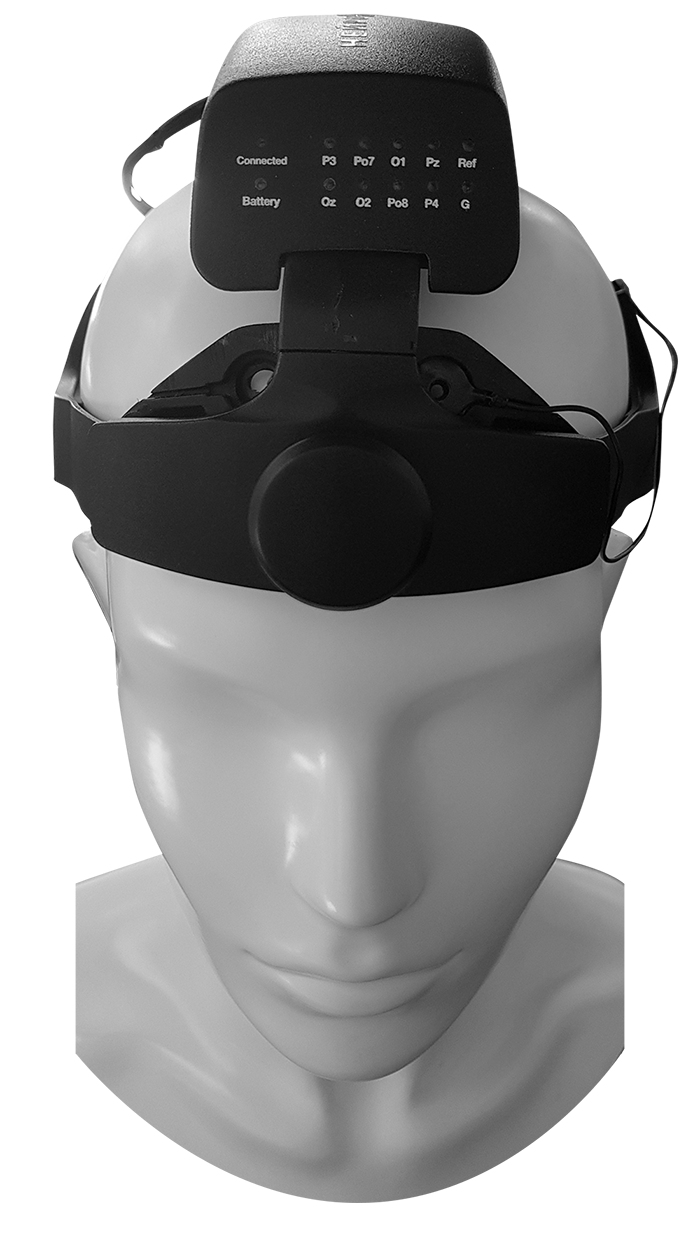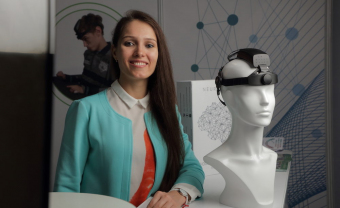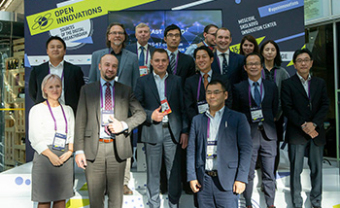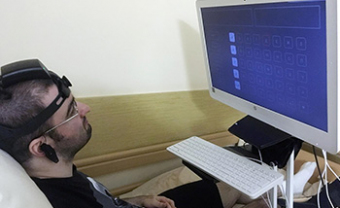
TASS has released excellent material about NeuroChat. TASS editor Anton Soldatov tested the device on himself and told us about his impressions, and we decided to share the full version of the article with you. Be sure to finish reading, at the end the most valuable.
A few years ago, a popular science attraction appeared at the Geek Picnic festival. Anyone could try himself in the role of Professor Xavier from the X-Men, giving telepathic commands. Right on the lawn, volunteers tried on rubber caps with electrodes, stared intently at a mechanical hand connected to a computer — and one of the fingers bent. And exactly the one that the person himself chose.
The whole process looked fascinating. It was not clear what practical application this technology could have. After all, it took about a minute to execute just one command. There is no point in controlling, say, a combat robot or at least a loader at this pace.
But the developers of the Russian Neural Network system based on the same technology have created a practical solution. Moreover, it is a commercial product.
Wait for the green light
I must admit, in the helmet of the "Neurochat" I look much more like a mysterious superhero technocrat. This is no longer a rubber cap, but a flexible black headset in which ten electrodes are implanted. No external wires — the signals are transmitted via the Wi-Fi module directly to the laptop.
"If it's something heavy or difficult, inconvenient, it won't enter people's lives," Alesya Chichinkina, the company's communications director, explains while I'm being prepared for the experience. — This is the tenth version, we have been working on this cap for a long time. What you're wearing is a headset with solid—gel electrodes. With a regular headset, the head is smeared with gel, then it has to be washed. And here they only need to be moistened with a little water."
Water is needed to increase electrical conductivity. The electrodes are in contact with the surface of the head, but they must record the bioelectric activity of the cerebral cortex. I look at the laptop monitor — there is an oval head with circles of different colors with numbers. Most of the circles are red — but gradually the color changes to yellow and green.
"The numbers are the resistance value,— Alesya comments. — Green is a sign that the resistance is minimal and it is possible to work. All this is intuitive so that anyone can figure it out. Our system is used by ordinary people, including the elderly, who do not work much with a computer."
Catching myself, I clarify: is the system suitable for everyone? Maybe there are contraindications? "Epilepsy," says Natalia Kucheeva, the instructor of the patronage service, who prepares me for the experience. "There are flickers on the screen, and in some types of epilepsy, these flickers can cause a seizure." I don't have epilepsy, so we can get started.
Concentration Test
The first, mandatory stage is calibration to adjust the program to my brain waves. "In fact, you have an electroencephalograph on your head that reads the bioelectric activity of the brain," says Alesya. — The brain is constantly working, and we are constantly writing your EEG. But we are working with one specific wave — P300. The amplitude of the vibrations of this wave changes when you are focused on an object that behaves in a certain way."
In the case of the "Neurochat", these are blinking, flashing movements on the screen. They cause a certain reaction in the brain. Everyone's brain activity is different, and during calibration, the system learns to understand what my reaction is. A keyboard appears on the screen, and one of the letters is enclosed in a red frame. I have to keep an eye on her.
To teach the system to understand my commands, I have to mentally react at the moment when the letter in the frame flashes, for example, to say a word to myself. And necessarily the same thing. "It can be both sound and movement," adds Alesya. "The emotional response helps: be happy, be surprised." Concentration should be maximum — it is impossible to be distracted.
3... 2... 1... let's get started! Damn, how fast they blink! Sometimes this happens twice in a row, and in each case, along with my letter, a number of neighboring ones light up. "The system thinks: I highlighted these five letters, he reacted to something," says Alesya. — Okay, now I will highlight differently, and two of the previous five will be highlighted, but three will not. There was a reaction again. So, one of these two. And so, by selecting your reactions, she understands: there were three different combinations, and in all there was only the letter A. So he chose the letter A."
Five minutes have passed, and the system has already gone through half of the alphabet. I feel like I've been making mistakes more often. And sometimes I even intuitively try to predict the flash and miss. It looks like an exam or a test for pilots or astronauts. And if I don't pass it? But now the result appears on the screen: 95/55. According to Alesya, this is a very good result. Now I'm ready to control the computer myself.
Everything is easier than it seems
The screen blinks constantly, and you'll have to get used to it. The backlight walks through all the menu buttons — to move from one section to another or select a command, you need to concentrate on the button for about a minute. There is a menu for quickly informing family members or a social worker: "I'm thirsty", "I want to sleep", "I'm cold", etc. And you can save your text in a notebook, send it via SMS and social networks.
Navigation through the menu is still difficult for me: the computer did not recognize the command and went to the wrong section. Natalia helps me get back — already with her hands. Now I want to try typing. The word "TASS" took me about five minutes, but I never made a mistake. The T9 mode is built into the system: if you start typing "lim", it will offer hints, for example, "lemon". The blinking speed of the screen can be adjusted, and the time record for one letter is now 15.5 seconds.
You can also change the dial mode. There is an option where the letters are located on the sectors of the circle, as on pieces of cake — three letters on each. The sectors not only blink, but also "jump out" slightly: it's easier to notice them this way. According to Alesya, this regime was introduced specifically for a girl who suffered a stroke after an aneurysm was removed. She began to have double vision, and it is difficult for her to distinguish the characters on a regular keyboard.
The refinement of the program, as well as the equipment, occurs constantly — in response to feedback from the users themselves. The most popular, by the way, was the notes service, not a chat for communication. Many write down thoughts, impressions and notes, keep a diary. And one man with a severe form of cerebral palsy learns the language by reprinting Pushkin's fairy tales. In total, the system has the functions of sending text by SMS, Viber, an internal network for communicating with system users, two games and a translator. And in the future, the authors plan to add smart home management.
Salvation for "trapped in the body"
"Neurochat" appeared in 2016. Now, according to Alesya, about 500 people are registered in the system and about 100 people use it at home. No special system requirements are needed for this — only stable Wi-Fi. The helmet comes with a box with solid-gel tabs and instructions. Users are scattered all over the country, once delivery was ordered even to Sakhalin.
Who would need such a system? Stephen Hawking, an astrophysicist who suffered from an incurable disease — amyotrophic lateral sclerosis, immediately came to my mind. This disease occurs suddenly and kills motor neurons. A person loses the ability to walk for several years, and then speak and even breathe. At the end of Hawking's life, only the cheek muscle worked, but with its help (more precisely, with the help of a computer) he communicated, typed the text of lectures and books.
Most often, people in this condition (and with other diseases that cause complete paralysis) use eye trackers — devices for capturing pupil movements. But they also have disadvantages, explains Alesya. The head must be in a fixed position, and calibration is required constantly (especially in older and cheaper versions). All this is not so easy to organize, especially if a person does not control his movements well.
According to Alesya, Neurochat has several advantages — both over alternative technologies such as eyetracking and similar developments. Firstly, it reads brain waves even if a person does not focus on the letter, but sees its blinking. Secondly, it does not require specially trained personnel. "This is the first consumer—class product of this kind," the Director of Communications emphasizes.
It is curious that even the design is made quite attractive — so that it looks more like a gadget, and not a medical device (however, manufacturers do not yet have the appropriate certification). And in one of the packaging options, they even wanted to make an allusion to the Apple design (a white box with a silver section).
According to Alesya, Neurochat has several advantages — both over alternative technologies such as eyetracking and similar developments. Firstly, it reads brain waves even if a person does not focus on the letter, but sees its blinking. Secondly, it does not require specially trained personnel. "This is the first consumer—class product of this kind," the Director of Communications emphasizes.
It is curious that even the design is made quite attractive — so that it looks more like a gadget, and not a medical device (however, manufacturers do not yet have the appropriate certification). And in one of the packaging options, they even wanted to make an allusion to the Apple design (a white box with a silver section).
One — help, the other — training
"In fact, those who are completely unable to communicate are a minority among our users,— Alesya clarifies. — There are just statistically fewer of them. But most use it to improve their condition. Among the same people with cerebral palsy, there are also those who control their arms and legs, but want to achieve better motor skills."
She cites the story of one of the users — Kirill. He had an atypical development of multiple sclerosis, in which muscles also fail. Usually this disease is ascending, but he had everything like an attack. Doctors even suspected a stroke. Kirill was an engineer, built thermal power plants, engaged in skiing and paragliding. And suddenly I forgot how to even speak.
Many of his abilities were later restored with the help of medications. Now he uses a wheelchair, but he can get up, move his arms, he says. And he uses the system for training. For example, he sits down and writes a text in a notebook. At first, the letters come out very uneven, barely readable — but after classes on the "Neurochat", according to Alesya, the handwriting noticeably improves. She shows two different "before and after" photos. The second handwriting is really a little better.
"We also launched the Neurochat for Healthy People direction — a joint neurotraining program that has been operating with Moscow Longevity for a year somewhere," says Alesya. — More than 500 people have passed through it. This is neurotraining, prevention of dementia. There are requests from parents, and we made games for them for children with restlessness. For example, "Memoris", when you need to remember a pair of identical pictures and open them in a row blindly with the power of thought.``
Here I am surprised. Why is brain work needed here? Why don't healthy children just play memory development games? "In a normal situation, you use routine processes," Alesya objects. — This is not some kind of extra load. And here you have to live completely in the moment, in this process. Don't be distracted by anything else. This does not happen in everyday life. It's like just running — and running a hundred meters at speed."
As a result, according to Alesya, concentration, memory, and information processing are trained. "The peculiarity of our cognitive processes is that they are all interconnected," she continues. — Here you can draw an analogy with muscles: you train the biceps, lift a dumbbell, but you have both the deltoid muscle and the triceps involved. So it is here."
Conquer a market that doesn't exist
The main challenge of development, according to Alesya, is not technological. The technology of neurocomputer interfaces itself is about 30 years old. Moreover, the leading Russian specialist in this field, Doctor of Biological Sciences Alexander Kaplan, acts as the scientific director of the project. The question is different: how to attract investments and find (and actually create) a sales market.
At the initial stage, Neurochat received funding under the National Technology Initiative. Now the price of the kit is 120 thousand rubles, which not everyone can afford. If the development receives the status of a technical means of rehabilitation, patients with serious disabilities will be able to receive compensation from the budget for it. We are currently working on this. "Neurochat" is also interested abroad — although due to the pandemic, these contacts have been put on pause.
Another option is to enter into contracts for the supply of kits to hospitals and rehabilitation centers. The project's website lists several institutions that use the "Neurochat" — among them MONIKI, the Center for Cerebrovascular Pathology and Stroke of the Pirogov Russian National Medical University, the Hospital of the Presidential Administration of the Russian Federation, the Research Institute of Emergency Pediatric Surgery and Traumatology, the hospital for war veterans. The general list includes about 60 institutions.
According to Alesya, some hospitals are afraid to enter into a supply contract, since the device does not have the status of a medical device. But this requires additional money, we need to conduct research. In the Web of Science database of scientific articles, one publication is still available on the use of "Neurochat" for patients with post-stroke aphasia (speech disorder). According to the authors, after ten sessions, the participants demonstrated improved performance in tests for attention, as well as auditory-speech memory.
The development has already been noticed and appreciated at many prestigious competitions and festivals. For example, in 2017, Neurochat was recognized by Rospatent as one of the 100 best inventions in Russia, and in September it won the Moscow Mayor's competition "Innovator of Moscow '' in the category "Changing Reality". And at the international exhibition CES Asia 2018 "Neurochat '' became the winner of the Inavation Awards in the category "Healthcare".
However, of all the awards and recognition signs, Alesya herself prefers a more informal one. This is a personalized pendant given by a girl Jasmine, who suffers from a severe form of cerebral palsy. Once a Neurochat specialist flew to Canada on purpose at the invitation of her relatives, and Jasmine herself gave it as a thank you. Now the pendant is stored in the company's office in Moscow.
Anton Soldatov
